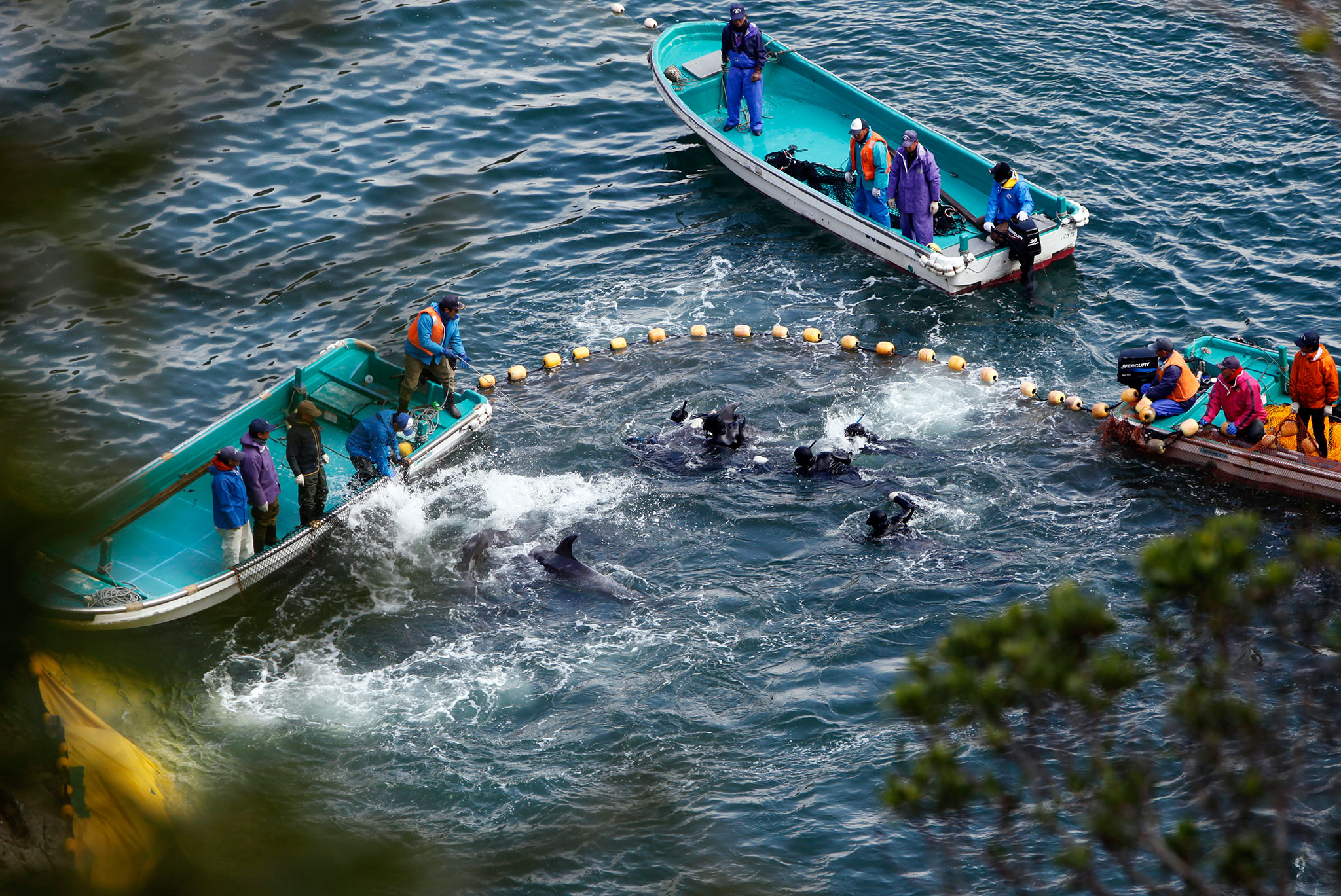Today, on National Dolphin Day, we devote some time to celebrate this intelligent and beautiful mammal. We also celebrate that the once glamorous marine animal performance industry has taken a serious hit in the last few years, due to increased awareness of the animal welfare issues involved. Animal rights activists have brought the effects of captivity on wild animals to the world’s attention –people have responded with boycotts and peaceful marches. What you may not be aware of, however, is that dolphins are being caught and killed by the thousands each year in a small cove off the coast of Taiji in the Higashimuro district of Japan. Those that display desirable traits for the dolphinarium industry will be sold on to the highest bidder; the rest are slaughtered for their meat. This gruesome event is kept so secret that a huge proportion of Japan aren’t aware of what is happening.
Only a small group of around 26 fishermen take part in this highly secretive act. They herd the dolphins into the cove by placing poles into the water and banging them with hammers to create a wall of sound which scares the dolphins towards the cove. Once there, they are then trapped in nets and usually left overnight, sometimes longer, before individuals are selected for captivity. The rest are slaughtered under tarpaulin sheets. This method of ‘drive fishing’ is a long-standing tradition in the town of Taiji, who have caught whales for their meat for hundreds of years.
However, this capture of dolphins on such a massive scale continues as marine parks will pay as much as $300,000 for a single, live dolphin. The more charismatic and desirable the species is, the more money it will make. The meat from the dolphins that are not chosen for performance is then sold to make sashimi, however there are huge health concerns surrounding dolphin meat. Studies on dolphins have shown dangerously high levels of toxic substances such as mercury and PCBs in their fatty stores, which can be extremely harmful to human health when consumed.
This issue was first brought to public attention in 2009 by the award-winning documentary ‘The Cove’, which exposed the gruesome events taking place in Taiji. The director Louie Psihoyos and his team of activists from Ric O’Barry’s Dolphin project and the Ocean Preservation Society suffered much resistance, harassment, and even risked arrest to expose this story to the world.
Dolphins are hugely social, inquisitive and intelligent mammals. Studies have shown that they undergo physical and emotional stress when they are stripped from their social groups, and isolated in an alien environment. They can swim up to 100 miles a day in the ocean, communicating with one another and hunting fish. Within captivity, they are often kept in unsuitable, small enclosures and forced to perform for rewards of food. The distress caused to dolphins by captivity has been shown to weaken their immune systems and make them susceptible to disease, meaning they often live much shorter lives in captivity than in the wild.
There have been reductions in the number of dolphins caught and killed in the cove each year, but the slaughter is still ongoing. The only way to stop the capture of wild dolphins for captivity is to remove the demand for them. If people stop attending dolphin shows, it will become unnecessary for marine parks to continue buying live dolphins from Taiji. Equally, if the people of Japan are made aware that dolphin meat can be poisonous, they are unlikely to continue buying it. Ric O’Barry’s Dolphin project and volunteers from Sea Shepherd continue to monitor the cove each year, putting pressure on the Japanese government to take action. Recently, the World Association of Zoos and Aquariums agreed to suspend membership of any zoos using dolphins from Taiji. As a result, Japanese zoos and aquariums voted to stop buying live dolphins from there.
Social media and public opinion is powerful. The impact that the 2013 documentary ‘Blackfish’ has had on rules regarding the captivity of Orcas is proof of this. Your voice matters and if we make our voices heard, we can be the drivers of change.
You can find out more information about Taiji and how you can help by following the links below:
Are Dolphin’s Too Smart for Captivity?
Salivary cortisol in captive dolphins (Tursiops truncatus): a non-invasive technique
Siannon Steel
(Image courtesy of National Geographic)

